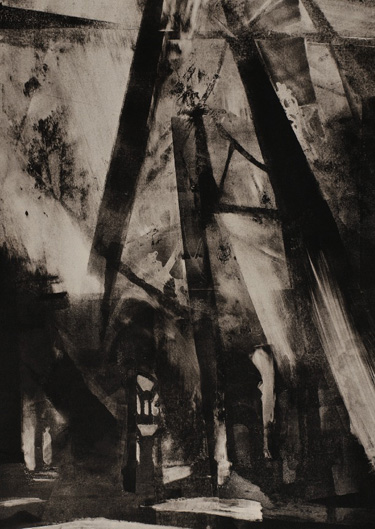
exhibitions
Phyllis Trout
BARDO
monoprints from 2010
June 2 - July 15, 2011
In this series of monoprints entitled Bardo, 2010, Ms. Trout begins each print’s plate covered in charbonel black ink. The artist employs a reductive process by wiping, scraping, and diluting the ink. Trout’s process relies on the intentional nature of her method, as well as on accidental mistakes.
A variety of substrata are revealed in each image. The artist works the solids and volumes of the surface ink, uncovering haunting imagery reminiscent of ancient grottoes, temples, and catacombs. Hand-made stencils are often used to push the boundaries of ambiguous space. These finely tuned explorations are closely akin to Giovanni Battista Piranesi’s “Imaginary Prisons” (Carceri d’Invenzione), a series of 16 etchings depicting labyrinthine structures of fictitious atmospheric subterranean vaults and stairways.
Unlike Piranesi- Trout’s vision is derived from the Buddhist concept “Bardo”, a Tibetan word that literally means intermediate state of being. According to Tibetan tradition the term bardo refers to the transitional state of existence between two lives on earth. For the prepared individual the bardo offers a state of great opportunity for liberation, while for others it can become a place of danger – as “karmic hallucinations” can impel one into a less than desirable rebirth.
Phyllis Trout earned her BFA from Kansas City Arts Institute, MO and has exhibited both nationally and internationally. Ms. Trout was a MacDowell fellow in 2001 and currently teaches at Friends Seminary, New York City as well as Parsons/New School University, New York City. Ms. Trout’s work is included in numerous public and private collections throughout the United States.
511 West 25th Street, Suite 504
New York, NY 10001
212.414.0827
Gallery Hours: Wed-Sat 12-6, and by appointment
Opening Reception: Thursday, June 2, 5-8 pm

Past Exhibitions
Aerialscapes
Gregory Forstner: Study for an American Archetype
The Long Fight for Kawtoolie: Portraits from the Jungles of Burma
America: The Third Century
more...
© 2025 Messineo Art Projects and Wyman Contemporary except where otherwise noted. All rights reserved.